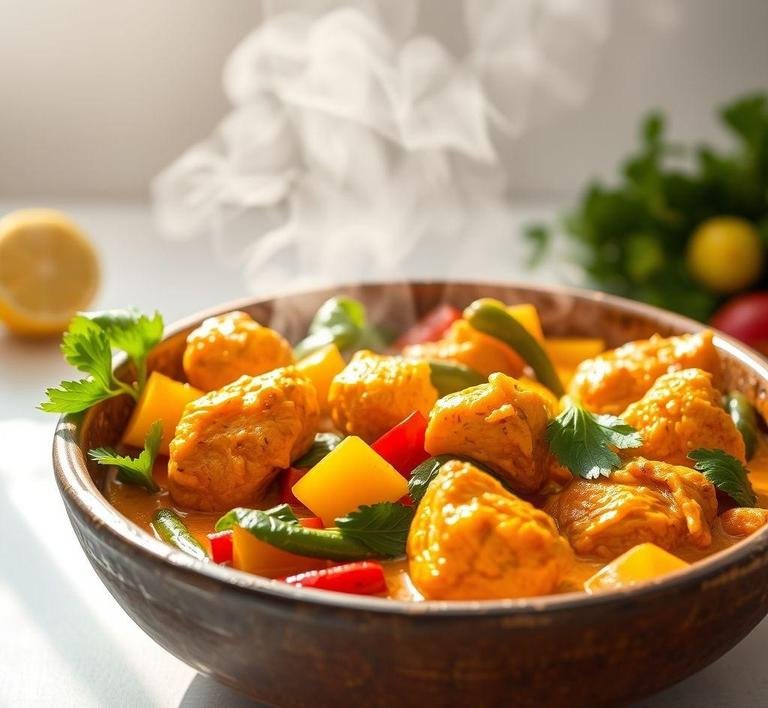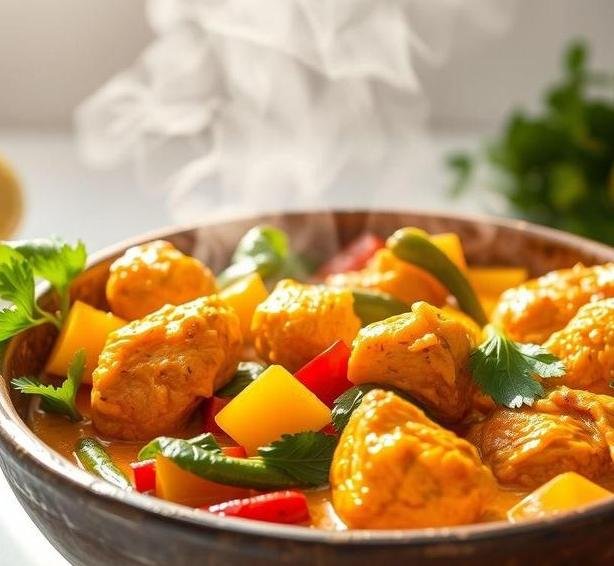Mary Berry’s Thai Chicken and Vegetable Curry is a vibrant, flavor-packed dish that brings together the rich, aromatic spices of Thailand with a British home-cooking twist. Known for her ability to create dishes that are both approachable and delicious, Mary Berry has taken the essence of Thai cuisine and simplified it for the home cook without sacrificing authenticity.
This curry is a celebration of fresh, healthy ingredients-chicken, vegetables, and fragrant herbs all come together in a creamy, slightly spicy coconut milk base. The use of Thai red curry paste provides a punch of flavor, while lime juice adds a touch of citrusy brightness. The dish is both comforting and fresh, making it ideal for family dinners or serving guests. With its balance of heat, sweetness, and creamy texture, this curry is sure to transport your taste buds to the bustling streets of Thailand, all while being easy to prepare in your own kitchen.
Mary Berry’s Thai Chicken And Vegetable Curry Recipe
Ingredients Needed

To prepare Mary Berry’s Thai Chicken and Vegetable Curry, you’ll need a combination of fresh, aromatic ingredients, as well as a few pantry staples. Here’s the list of ingredients:
- Chicken: Typically, skinless chicken breasts or thighs are used for this recipe. They are tender and absorb the curry flavors well.
- Vegetables: A variety of vegetables such as bell peppers, carrots, and courgettes (zucchini) offer both color and texture. You can also add baby corn or mushrooms for extra flavor.
- Red Curry Paste: This is the base of the curry’s flavor, adding depth and heat. It’s typically made from chili peppers, garlic, lemongrass, and other spices.
- Coconut Milk: This provides the signature creamy texture and rich flavor that is a hallmark of Thai curries. It also balances out the heat from the curry paste.
- Garlic and Ginger: These aromatics form the foundation of the curry, providing a subtle heat and earthy undertones.
- Fish Sauce: Essential for that savory umami flavor, fish sauce is a key ingredient in Thai cuisine.
- Lime: The juice and zest of fresh lime are used to brighten the dish and provide a citrusy kick.
- Coriander (Cilantro): Fresh coriander is typically sprinkled over the curry just before serving for added freshness.
- Chili (Optional): For those who prefer extra heat, a fresh red chili or two can be added.
- Sugar: A touch of sugar helps to balance out the spices and acidity from the lime and curry paste.
Equipment Needed
While Mary Berry’s Thai Chicken and Vegetable Curry doesn’t require an extensive array of gadgets, there are a few key pieces of equipment that will help make the process smoother:
- Large Frying Pan or Wok: A deep, wide pan or wok is ideal for cooking this curry, as it provides enough room for sautéing the ingredients and simmering the curry without making a mess.
- Sharp Knife: To chop the vegetables and chicken into bite-sized pieces, a sharp knife is essential for ease and precision.
- Chopping Board: A sturdy chopping board helps keep your kitchen organized while prepping the vegetables and chicken.
- Ladle or Wooden Spoon: For stirring and ensuring that the curry doesn’t stick to the bottom of the pan.
- Measuring Spoons and Cups: To measure out the curry paste, fish sauce, lime juice, and other ingredients with accuracy.
- Lime Zester (Optional): If you prefer fresh lime zest for extra fragrance, a zester is helpful for getting just the right amount of zest without any bitter pith.
Instructions To Make Mary Berry’s Thai Chicken And Vegetable Curry
Now that you have your ingredients and equipment ready, let’s break down the process of making this flavorful Thai chicken curry. It’s a straightforward recipe that can be prepared in about 30 minutes, making it perfect for a quick yet indulgent dinner.
Step 1: Prep Your Ingredients
Begin by preparing the vegetables and chicken. Slice the chicken into bite-sized chunks, making sure they are uniform in size for even cooking. Cut the carrots into thin slices, and chop the courgettes (zucchini) and bell peppers into small pieces. Set aside the chopped vegetables in a bowl.
Step 2: Cook The Chicken
Heat a little oil in a large frying pan or wok over medium-high heat. Once the oil is hot, add the chicken pieces and season with a pinch of salt and pepper. Cook the chicken for 5-7 minutes, stirring occasionally, until it’s browned on all sides. Once the chicken is fully cooked, remove it from the pan and set aside.
Step 3: Sauté The Aromatics
In the same pan, add a bit more oil if necessary and sauté the garlic and ginger over medium heat for about 1-2 minutes until fragrant. Be careful not to burn them-this step is essential for building the base flavor of your curry.
Step 4: Add The Curry Paste
Once the garlic and ginger are fragrant, stir in the Thai red curry paste. Cook it for another 1-2 minutes, stirring constantly, to allow the paste to release its full flavor. The aroma of the curry paste should be intoxicating at this point!
Step 5: Add The Coconut Milk And Simmer
Now, pour in the coconut milk, stirring well to combine it with the curry paste. Bring the mixture to a gentle simmer, allowing the flavors to meld together. If the sauce appears too thick, you can add a small splash of water or chicken stock to reach your desired consistency.
Step 6: Add The Vegetables
Add the prepared vegetables to the pan, stirring to coat them in the curry sauce. Let them cook for 10 minutes, or until they are tender but still vibrant. You don’t want to overcook them, as they should retain their texture and color.
Step 7: Season And Finish
Once the vegetables are cooked, add the cooked chicken back to the pan. Stir in the fish sauce, lime juice, and a pinch of sugar to balance the flavors. Taste the curry and adjust the seasoning, adding more lime juice, fish sauce, or sugar as needed to achieve a balanced flavor.
Step 8: Garnish And Serve
Once everything is cooked through and the curry is well-seasoned, remove the pan from the heat. Serve the curry hot, garnished with fresh coriander leaves and a wedge of lime on the side. You can serve it over steamed jasmine rice or noodles for a complete meal.
Tips And Tricks
- Customize the Spice Level: If you prefer a milder curry, reduce the amount of red curry paste or leave out the fresh chili. Alternatively, if you like it spicy, feel free to add extra chili or even a pinch of chili flakes.
- Make It Ahead of Time: This curry can be made in advance and stored in the refrigerator for up to 2 days. In fact, the flavors develop even more after sitting overnight, making it an excellent dish to prepare ahead of time.
- Use Different Vegetables: The beauty of this recipe is its versatility. You can swap in other vegetables like broccoli, peas, or spinach depending on what you have available or what’s in season.
- Coconut Milk Substitutes: If you’re looking to cut down on calories or want a dairy-free version, you can substitute full-fat coconut milk with light coconut milk or even almond milk for a slightly different flavor profile.
- Add Fresh Herbs: For added freshness, sprinkle additional chopped fresh herbs like mint or Thai basil over the curry just before serving.
Mary Berry’s Thai Chicken and Vegetable Curry is a delightful fusion of Thai-inspired flavors and simple, hearty ingredients. With its creamy coconut milk base, fragrant red curry paste, and tender chicken, this dish offers a satisfying balance of heat, sweetness, and richness. The fresh vegetables add texture and color, while the lime juice brings a zesty lift that ties everything together.
Whether you’re a seasoned home cook or a beginner, this curry is a great way to dip your toes into Thai cuisine without feeling overwhelmed. It’s easy to prepare, customizable, and perfect for busy weeknights or dinner parties alike. Plus, with a few tips and tricks, you can make it your own, ensuring that each time you cook it, it’s a flavorful success.
Easy Recipe Variations For Mary Berry’s Thai Chicken And Vegetable Curry

Mary Berry’s Thai Chicken and Vegetable Curry is a delightfully aromatic dish, blending the vibrant flavors of Thailand with the richness of a comforting curry. While her recipe is a classic, there are many ways to add your own spin to it depending on your taste preferences, dietary needs, or what ingredients you have on hand. Here are some easy recipe variations you can try:
1. Add Different Vegetables
While the recipe usually features carrots, peppers, and onions, you can get creative with the vegetables you add. Consider including sweet potatoes for a rich, earthy sweetness that pairs perfectly with the curry’s flavors. Broccoli or cauliflower can be tossed in for added texture and nutritional value. Baby corn and mange tout are classic additions in Thai curries, adding a crunchy bite and balancing the soft, tender chicken and vegetables.
2. Protein Swaps
If chicken isn’t your protein of choice, the recipe can easily be adapted for different meats or plant-based options. Turkey breast works well, offering a leaner alternative to chicken. Alternatively, if you’re looking to make the curry vegetarian or vegan, swap the chicken for tofu or tempeh. These protein-rich alternatives soak up the curry’s flavors beautifully. Paneer (Indian cheese) also provides a hearty, flavorful alternative for a vegetarian twist.
3. Spice It Up
Mary Berry’s curry has a mild spice level, but if you’re someone who enjoys a little heat, you can kick up the flavor with fresh chilies or chili paste. Adjusting the amount of red curry paste or using a more fiery variety can give the dish a robust, spicy edge. For those who like it extra spicy, serrano peppers or bird’s eye chilies can make the dish sing with fiery heat.
4. Coconut Milk Variations
Coconut milk is the foundation of the curry’s creamy texture. To deepen the flavor, you could use coconut cream for an even richer, thicker sauce. If you’re looking for a lighter version, light coconut milk can be substituted for the full-fat variety. You could also add a splash of lime juice to cut through the richness and brighten up the dish, balancing the creaminess of the coconut milk.
5. Herb Infusions
While the recipe traditionally uses cilantro as a garnish, there are other herbs you can introduce into the curry itself. Thai basil has a peppery, anise-like flavor that complements the coconut milk base beautifully. Mint can offer a refreshing note, providing a contrast to the rich flavors of the curry. A few finely chopped lemongrass stalks can also impart a citrusy aroma, further enhancing the Thai essence.
6. Switching The Base
While rice is typically served with this curry, you can change it up by serving it with other bases like quinoa, which provides a nutty flavor and extra protein, or cauliflower rice for a low-carb option. Noodles, especially rice noodles, are another great accompaniment that absorbs the sauce wonderfully.
Storing Leftovers
Storing leftovers of Mary Berry’s Thai Chicken and Vegetable Curry is simple, but proper storage ensures that the dish maintains its freshness and flavor when you revisit it. Here’s a guide on how to store and reheat the curry:
1. Cool And Store
After cooking, let the curry cool down to room temperature before storing it. This helps prevent condensation and the growth of bacteria. Once it’s cooled, transfer it to an airtight container. If you plan to store the curry for longer than a couple of days, it’s a good idea to divide it into smaller portions for easier reheating.
2. Refrigeration
Thai chicken curry can be stored in the fridge for up to 3-4 days. When stored properly, the curry will keep its rich flavor and creamy texture. If you’ve added more liquid or vegetables, the curry may slightly thicken upon refrigeration, but it should still be delicious when reheated.
3. Freezing
If you want to store the curry for a longer period, you can freeze it. For best results, let it cool completely before freezing. Portion the curry into individual servings, so you can easily thaw and reheat just the amount you need. When freezing, be sure to use a freezer-safe container or freezer bags to prevent freezer burn. The curry will keep in the freezer for up to 2-3 months.
4. Reheating
To reheat, you can do so either in the microwave or on the stovetop. When reheating on the stove, use a medium heat and stir occasionally to avoid burning. You might need to add a bit of water or extra coconut milk to bring the sauce back to the desired consistency. In the microwave, heat the curry in short bursts of 1-2 minutes, stirring in between to ensure even heating.
5. Avoid Repeated Reheating
Like with most curry-based dishes, it’s best to only reheat the curry once. Repeated reheating can cause the chicken to become tough, and the vegetables may lose their crispness. If you have too much curry left over, consider using it as a filling for a wrap or sandwich the next day, transforming it into a fresh meal.
What To Eat With Mary Berry’s Thai Chicken And Vegetable Curry?
While the curry itself is a complete and flavorful dish, pairing it with the right sides can elevate the overall meal experience. Here are a few ideas to round out your meal:
1. Steamed Jasmine Rice
The most classic pairing with Thai curry is a bowl of fluffy steamed jasmine rice. The fragrant rice soaks up the curry sauce beautifully and serves as a neutral base that complements the complex flavors of the curry.
2. Naan Bread
If you want to mix a little Indian influence into your meal, a warm piece of naan bread can be perfect for scooping up the curry. The soft, pillowy bread contrasts nicely with the richness of the sauce.
3. Crispy Spring Rolls
Light, crispy spring rolls, either vegetable or shrimp-filled, add texture and a burst of freshness to balance the rich and creamy curry. Serve them as a starter or alongside the curry for a crunchy contrast.
4. Asian Slaw
A tangy, crunchy Asian slaw can cut through the richness of the curry and add a refreshing crunch. Toss shredded cabbage, carrots, and cucumber with a simple dressing of rice vinegar, sesame oil, and a pinch of sugar for a sweet and sour bite.
5. Pickled Vegetables
In true Thai style, a small side of pickled vegetables such as daikon radish, carrots, and cucumbers provides a tangy, slightly sour element that balances the curry’s richness. It’s an excellent contrast that brightens the dish.
6. Coconut Rice
If you’re a fan of coconut flavors, consider making coconut rice to serve alongside the curry. This subtly sweet rice complements the coconut milk in the curry and creates a harmonious meal.
Conclusion
Mary Berry’s Thai Chicken and Vegetable Curry is a versatile, comforting dish that can easily be adapted to suit a variety of tastes and dietary preferences. Whether you want to experiment with different vegetables, try a new protein, or add a little more spice, the curry offers a wide range of possibilities. Storing and reheating leftovers is also a breeze, allowing you to enjoy this delicious dish for several days. Pairing it with classic accompaniments like jasmine rice, naan, or crispy spring rolls ensures that your meal is well-rounded and satisfying. Whether you’re serving it for a weeknight dinner or a special occasion, Mary Berry’s Thai Chicken and Vegetable Curry is sure to impress with its balance of flavors, richness, and warmth.
FAQs
What Are The Main Ingredients In Mary Berry’s Thai Chicken And Vegetable Curry?
Mary Berry’s Thai Chicken and Vegetable Curry includes boneless chicken breasts, mixed vegetables like bell peppers, carrots, and courgettes, alongside aromatic ingredients like garlic, ginger, and lemongrass. It also features coconut milk, Thai red curry paste, lime leaves, and a splash of fish sauce for an authentic flavor. Fresh coriander and lime are often used as garnish.
Can I Make Mary Berry’s Thai Chicken And Vegetable Curry Ahead Of Time?
Yes, Mary Berry’s Thai Chicken and Vegetable Curry can be made ahead of time. The curry tends to develop richer flavors when it sits for a few hours or overnight. To store, let it cool completely, then refrigerate in an airtight container. You can reheat it on the stove or in the microwave, but ensure it is piping hot before serving. However, fresh vegetables like bell peppers might soften more during reheating.
How Spicy Is Mary Berry’s Thai Chicken And Vegetable Curry?
Mary Berry’s Thai Chicken and Vegetable Curry has a mild to medium spice level, depending on the amount of Thai red curry paste you use. If you prefer a milder dish, you can reduce the amount of curry paste or substitute with a milder paste. For those who enjoy a spicier kick, you can add extra chili or fresh chili slices to the curry for added heat.


